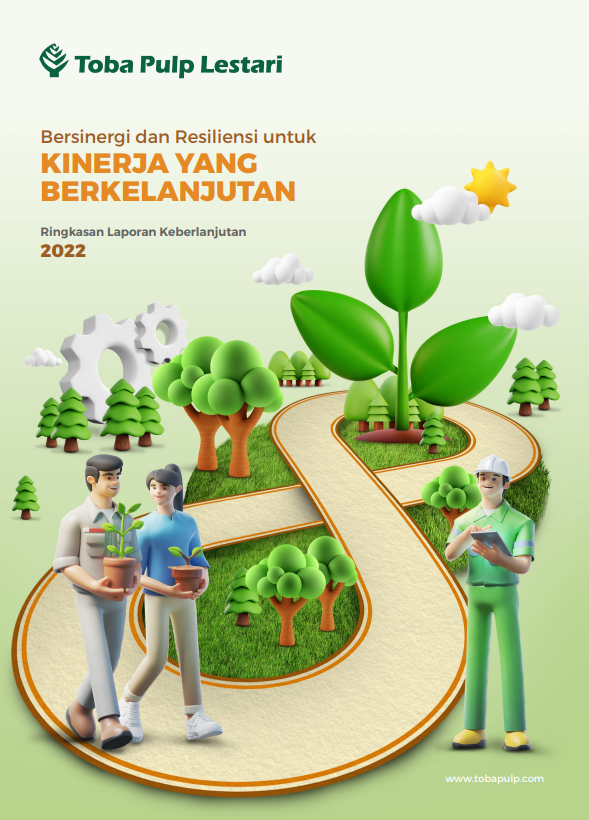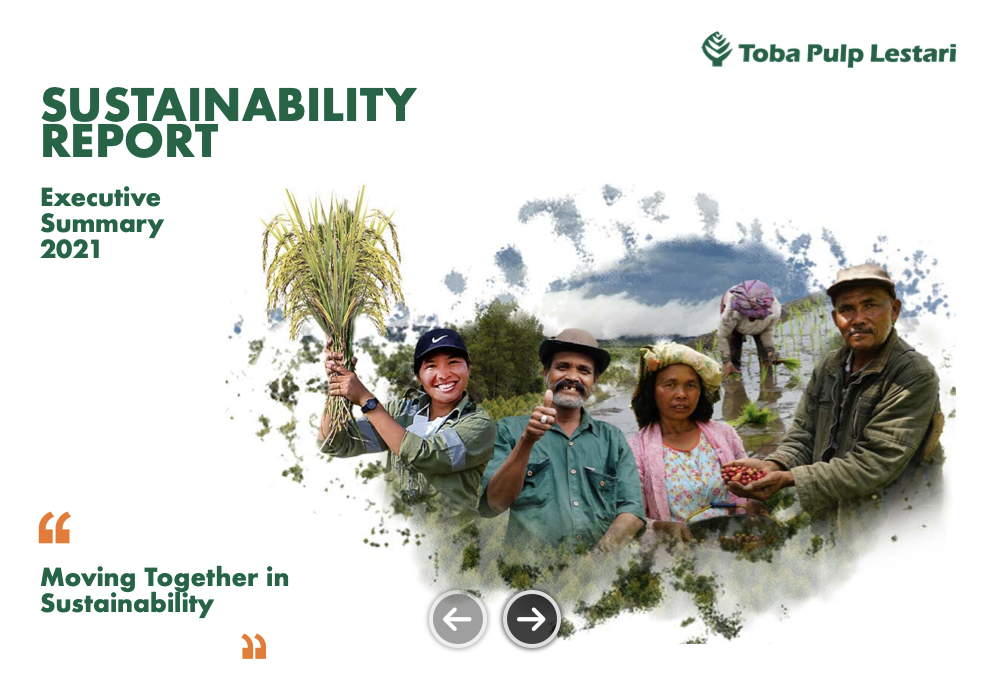198.429 Tons of Pulp Production in 2022
Sustainability Policy
PT Toba Pulp Lestari Tbk (“the company”) is a forest management company committed to accountability, implementation of best practices in social, environment and business affairs with the objective to be a good business partner and accountable member of the local, national, and global community.
This sustainability policy covers protection and conservation of forest by supporting the conservation of carbon and biodiversity The company proactively supports local people through CD/CSR program, especially in the development of entrepreneurship and agriculture at the village level The company respect traditional ethnic groups and their rights and aims for clean production through the reduction of emissions and control of waste.
The company implements responsible practices in the workplace, including strict compliance with all relevant legislation, participation in sustainable forest management and timber legality certification programs, a strict no burning policy, and implementation of a chain of custody system.
The company is committed to good company governance and have an Independent team appointed by North Sumatera Governor, community and civil society to ensure transparency of execution of the sustainability policy, a responsive and transparent complaint mechanism and to oversee collaboration with third parties to support sustainable forest development.
Sustainability Report
PT Toba Pulp Lestari, Tbk is a publicly listed company that is required to publish its Sustainability Report in accordance with applicable regulations in Indonesia. We use a stakeholder engagement and local regulations in our materiality topics of economic, environmental, social and governance with the latest Global Reporting Initiative (GRI) standard guidelines.
Please kindly view and explore our report, below:
Summary Sustainability Report
For further inquiries, please contact us on:
Main Office
PT Toba Pulp Lestari Tbk.
Level 3, East Tower, Uniplaza Building, Jl. Letjend. Haryono MT No. A-1
Medan, North Sumatra
Indonesia 20231
Tel. +62 61 453 2088
Fax. +62 61 453 0967
Email. investor_relation@tobapulp.com
Forest Conservation Management
Conserving the Forest
In PT. Toba Pulp Lestari Tbk. (TPL), we believe in practising sustainable forest plantation and advocate the ecological contributions and importance of forest landscape. We understand the tropical forest landscapes hold large stores of carbon and biodiversity. It functions as a high canopy with a mix of vegetation from grassland to scrub as well as regenerating to dense forest. Thus, since 2016, TPL is committed to executing comprehensive and robust HCV/HCS assessments conducted by independent experts before embarking on any new plantation initiatives in our effort to the advocacy of protecting and conserving identified HCV and HCS areas.
High Conservation Value (HCV)/ High Carbon Stock (HCS)
According to the High Conservation Values (HCV) Common Guidance Toolkit, HCVs are defined as biological, ecological, social or cultural values which are considered outstandingly significant or critically important. The aforementioned, definition is further categorized into six aspects as listed below:
HCV 1: Species diversityConcentrations of biological diversity including endemic species, and rare, threatened or endangered species, that are significant at global, regional or national levels.
HCV 2: Landscape-level ecosystems, ecosystem mosaics and IFLLarge landscape-level ecosystems, ecosystem mosaics and Intact Forest Landscapes (IFL) that are significant at global, regional or national levels, and that contain viable populations of the great majority of the naturally occurring species in natural patterns of distribution and abundance.
HCV 3: Ecosystems and habitatsRare, threatened, or endangered ecosystems, habitats or refugia.
HCV 4: Ecosystem servicesBasic ecosystem services in critical situations, including protection of water catchments and control of erosion of vulnerable soils and slopes.
HCV 5: Community needsSites and resources fundamental for satisfying the basic necessities of local communities or indigenous peoples (for livelihoods, health, nutrition, water, etc...), identified through engagement with these communities or indigenous peoples.
HCV 6: Cultural valuesSites, resources, habitats and landscapes of global or national cultural, archaeological or historical significance, and/or of critical cultural, ecological, economic or religious/sacred importance for the traditional cultures of local communities or indigenous peoples, identified through engagement with these local communities or indigenous peoples
Managing Sustainable Forest Plantation
In TPL, some of the key measures we take in managing sustainable forest plantation upon identifying an HCV/HCS area are as follow:
- Formulate plans and strategy to manage and protect the HCV/HCS areas that have been identified:
- The formulated plans and strategy will include the schedule for monitoring the HCV/HCS areas to ensure that no illegal activities i.e. logging, mining and poaching occur. In the HCV/HCS areas identified for its cultural values, our monitoring plan is to ensure that the boundaries are respected and that there are no illegal activities such as encroachment by external parties in our concession area.
- Proactive measures to preserve areas with confirmed historical and/or conservation sites.
- Set up buffer zones and Green Belt areas to mitigate the risk towards the identified HCV/HCS area.
- Social Economic Environment Development Program – (Livelihood Plantation) – Tanaman Kehidupan with indigenous communities in collaboration with the local and central government as part of TPL’s sustainable strategy to creating sustainable opportunities (e.g. elevating the social and economic aspects of the communities around HCV/HCS areas).
HCV/HCS Definition Source: www.hcvnetwork.org



